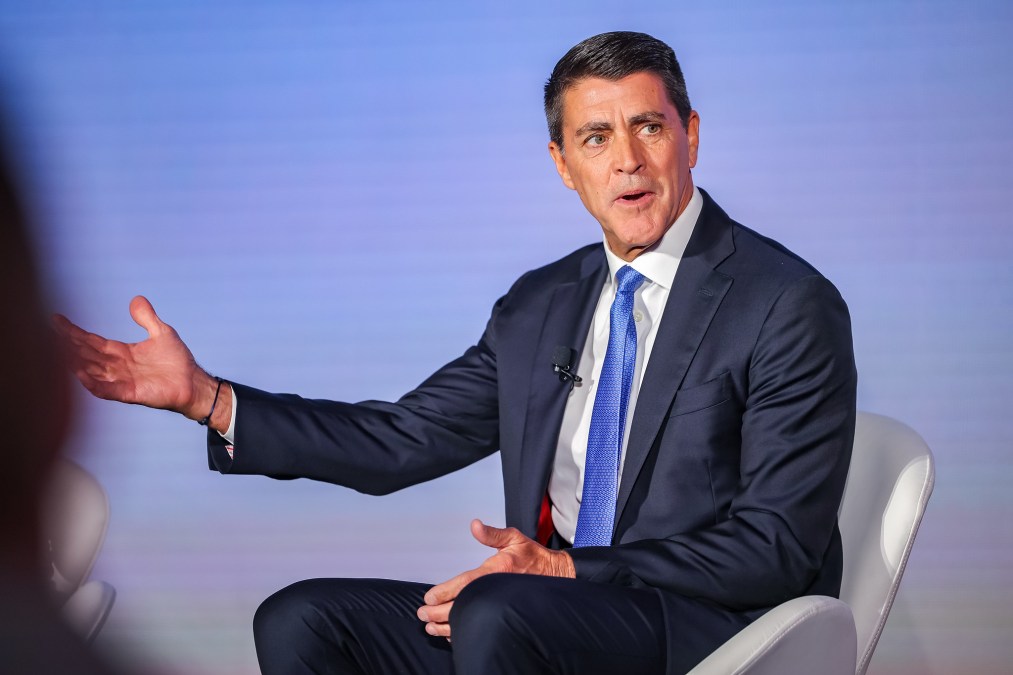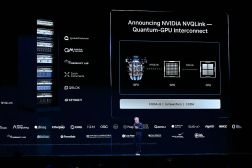Q&A: Workday CEO sees $1B opportunity in governmentwide HR modernization

The federal government could save $1 billion in productivity simply by modernizing outdated legacy HR systems across agencies, according to research that Workday put out last month.
But that’s just the tip of the iceberg, if you ask the company’s CEO Carl Eschenbach, who told FedScoop in an exclusive interview that there’s an appetite among some agencies in the Trump administration to move to a common, cloud-based HR system. Beyond making federal human capital workers more productive, such a platform that spans across the federal government could completely transform the way it manages, moves, optimizes and upskills personnel, Eschenbach said, emphasizing how different that conversation is from those Workday has had with federal agencies in the past.
“That didn’t happen in the past. You go to one agency, they were siloed,” he said. “Now we’re talking about things like a governmentwide platform to be able to manage your entire 2 million-plus workforce and do it on the same platform. We start to learn about the skills of our employees. We start to think about how we can move people from one organization to the other to meet the needs of a project, right?”
Before a day on the Hill meeting with lawmakers to educate them on the role his company could play in modernizing the federal government’s workforce and financial portfolios, Eschenbach also shared how Workday’s success with Fortune 500 companies has it ready to move quickly to modernize federal agencies, the “unfair advantage” it has with AI technology, and much more.
This transcript has been edited for clarity and length.
FedScoop: Let’s start with the $1 billion question: Workday recently produced research that makes the case that outdated legacy HR systems cost the federal government $1 billion every year, thus justifying an imperative to transform federal human capital management. That’s a massive number. How are you working to solve that?
Carl Eschenbach: There’s a billion dollars of productivity and efficiencies lost on an annual basis based on our research, because of antiquated systems that are on-premise supporting our employees today. That’s massive, right? So when people talk about government efficiencies, there’s a perfect example where I think the government will lean into someone like Workday, leverage our platform to drive efficiencies, but also drive massive productivity changes, right? And I think we often say that AI will drive a step function change in human productivity, and the way you’re going to do that is with a modernized platform like Workday. And that’s research we did and we got back. This is what we’re hearing from the government itself. A billion dollars of government efficiency across your people is pretty impressive.
FS: When you put it like that, it sounds like a fairly simple move for this administration, which is prioritizing efficiency and savings, to cut $1 billion. Is it that simple?
CE: It is a transformation, though. You do have to go through a transformation to move from on-premise into the cloud environment for HR and finance. But this is what we do. We do this for a living. We do massive transformations. And we’re ready to step up and help the government do it as well. We’re already in the process of doing this, as you know, across a number of different agencies. We have the Department of Energy, which was a huge success. And then we’re working in the DOD area with DISA and on the intel side with DIA.
So, yeah, we’re ready to step up and help the government achieve their goals and deliver an employee experience that just hasn’t existed probably in decades across the federal or public sector. That’s our opportunity. And I don’t think it’s ‘if.’ It’s ‘when and how fast?’ And it’s about moving through all of the policies and the changes that the administration is making, right? I think the opportunity is there. It’s really about: How do we accelerate actually getting done and people making decisions to move forward?
FS: You mentioned some contracts you have with federal agencies. Those are large agencies. How does that work and transformation journey compare to the work Workday is most known for on the commercial side?
CE: It’s different, but again, there are a lot of similarities. The biggest difference is the platform itself, and some of the requirements the government has around security and compliance and controls of the system itself. So we can’t just take our commercial platform, roll it into the federal government and support DIA or DISA with the existing platform. But we leverage the majority of the platform, and then we put the enhancements on top of it, especially around the security requirements. That’s the biggest difference. But there’s a lot of commonality across our commercially available platform today. And in fact, as we go into other agencies outside of DOD and the intel agencies, one of the things the government has been telling us is they want to drive efficiencies through standardization. Not everything is a snowflake, and not every agency needs their own thing. And when you do these modernizations or transformational exercises, one of the things you get on the other side of it, if you do it right, is you standardize your process and controls and your workflows, and that’s what drives the efficiencies and productivity gains for the employees, right? There’s a lot of commonality in what we do with the major enterprises that we work with as well. But, to your point, I think there’s a belief that everything is radically different [in the public sector] when, in fact, there are differences, but it’s not a radical differentiation from what we see in a Fortune 500 company deploying or re-platforming to Workday. Which gives us the confidence that we can do it, and we can do it at a very rapid pace as well. So that’s why we’re so confident. And this is one of the reasons, quite honestly, the last two years, we’ve gone all in on the U.S. federal government, because we see the opportunity. We’ve had enough experience now to say that it’s not that different than what we’re doing in the commercial world, and we get to leverage all of that 20 years of experience and bring it to the federal government to modernize their systems.
FS: There’s a very transformative moment going on in Washington and the federal government right now. And whether it’s through executive mandate or other changing power dynamics, as you mentioned, there is a push to drive more commercial, innovative technologies into agencies. How has that impacted the way you’re approaching business with the federal government?
CE: Because the government is looking to drive efficiencies across all the agencies, across all different sectors, we absolutely see them leaning in more aggressively to folks like us than we’ve historically seen in the past. We also see a bit more of a sense of urgency, right? There’s a whole speed component to this and how rapidly they want to make changes to drive transformation. So we do see a pretty big change with the new administration, both from policy as well as interest in modernizing, as well as doing it faster than they’ve done in the past. But we see the absolute change in the administration and their desire to run the federal government as much as a business as we see in the commercial world today, and it comes back to efficiencies. It comes back to speed and agility.
There’s also this notion of starting to move your federal workforce across agencies, and you can’t do that with a siloed approach like we see today with all the different systems. Every agency has their own system in place. It’s on-premise. Some might be a little bit in the cloud. But if you have a common platform, you now give talent mobility and talent optimization opportunities to the federal government to move your workforce around. That’s a really big part of the discussions we’re having across the different agencies. That didn’t happen in the past. You go to one agency, they were siloed. Now we’re talking about things like a governmentwide platform to be able to manage your entire 2 million-plus workforce and do it on the same platform. We start to learn about the skills of our employees. We start to think about how we can move people from one organization to the other to meet the needs of a project, right? So that’s a different conversation than we’ve seen in the past.
FS: You’re here in D.C. because you have several meetings with lawmakers on the Hill. Obviously they have a role in how federal workforce modernization could play out. What is the strategy in working with Congress?
CE: We have four or five different meetings on the Hill just in the next 24 hours. A lot of it is education — educating them on the power of the Workday platform and the potential impact it can have on the federal government, for all of us to achieve our mission as a country. I want to make sure that the federal government understands that an investment in the new architecture is required to actually drive change in how we’re supporting our employees. A lot of times in the past, if you talk to people here, my opinion is they wouldn’t want to spend money. But to modernize, you have to spend money, and through that modernization, you actually save money. The inefficiencies we see on-premise are just bonkers what you see today, and we’re helping to modernize that. We see an almost $3 billion [savings] opportunity just for us to help modernize these infrastructures going forward. So we’re meeting with different people on the Hill who are responsible for different areas across the federal government, and as much as anything else, it’s us educating them on Workday and the impact we can have on the government.
FS: We haven’t touched much on AI. But recently, there’s been more of a fever pitch in the federal space around agentic AI. How are you looking to cater to the federal government’s adoption of that, particularly as a driver of efficiency?
CE: I think the first thing is we need to continue to educate — not just the federal government and all the agencies, but I’d say everybody in general — that AI is not going to displace all the human workers in the world. We are going to learn to peacefully coexist and leverage this technology to drive efficiencies and drive productivity gains. When you talk about productivity gains, you’re talking about humans being more productive. So I think one of the narratives that we’re spending time educating the government on is the fact that AI will help drive your efficiencies and drive productivity gains. Will some jobs be eliminated? Yeah, potentially. So we’re not naive, but at the same time, we also know there’s so much work to be done out there. What we need to do is leverage this technology so we create a new opportunity for existing employees to have new skills to go and work on more productive stuff, [and] let the mundane tasks be taken care of by AI.
We think we actually have an unfair advantage around technology when it comes to AI because of our data. We have 70 million users on our platform, a billion transactions a year. Today we’re processing, I think it’s up to 25% of the job applications in the United States. This all gives us an incredible data set to build domain-specific agents that will support our customers, both in the public sector and the private sector. So we’re huge fans of AI. We know the power of it. We do believe in regulation, but not overregulating, right? Because we want to drive innovation. I think the administration has shown a willingness to be a little bit more, if you will, less aggressive on regulation to allow AI.
But, yes, the government is actually very interested in it. It comes back to efficiencies. Efficiencies and productivity gains are two big factors that you get when you implement AI, and it’s something I think we’re doing as well as anyone in the market today. We’re bringing to market our own agents. We believe in the quality of agents, not quantity. There are people talking about bringing thousands of agents to the market. But if you can’t show true business value and business outcomes with your agents, these agents actually can pose a threat, because they’re just running around wild right in your infrastructure, getting access to data that maybe they shouldn’t. So you have to have security, policy and control around those agents as they enter into the enterprise to actually provide the right level of value, or there’s a risk that you can pose with what we call ‘agents for all.’






